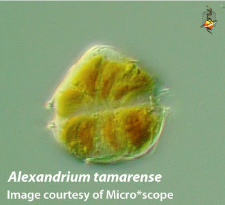Harmful algal bloom dynamics

With the recent development genomic resources for A. tamarense, it is now possible to conduct studies of environmental regulation of gene expression to better understand bloom dynamics and cellular metabolism in this important species at a level that has never before been possible. The goal is to identify transcriptionally regulated genes and pathways during the three general stages of a bloom: initiation, developments, and termination.
Specifically the lab is using microarrays for A. tamarense to
1) Identify key genes involved in the initiation of A. tamarense blooms, specifically those regulated during the germination of resting cyst life stages;
2) Identify the key genes involved in the development and maintenance of A. tamarense blooms, specifically those involved in the assimilation of organic and inorganic nutrients, the process of photosynthesis, the production of toxins, and the cell division cycles;
3) Identify the key genes involved in the termination of A. tamarense blooms, specially those regulated in response to nutrient limitation, and during the transition from vegetative growth to the sexual cycle that result in resting stage formation; and
4) Investigate the physiological state of dinoflagellate cells in situ by comparing expression profiles of a natural bloom population with the data generated from laboratory culture.